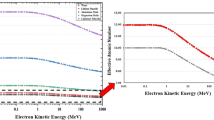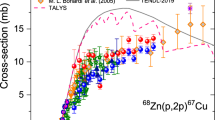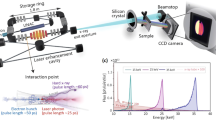Abstract
FOR a single element, the three γ-ray processes—photoelectric, Compton and pair production, can be expressed as a function of photon energy hν and the atomic number Z of the element. At a given photon energy, the interaction is proportional to Zn where n is between 4 and 5 for the photoelectric effect, 1 for the Compton effect, and 2 for pair production1,2. For the purposes of γ-ray attenuation, a heterogeneous material, consisting of a number of elements in varying proportions, can be described as a fictitious element having an effective atomic number Zeff. In the study of the X-ray energy absorption of certain biological specimens Spiers3 used the expression Z2.94eff = ɛαiZ2.94i, where Zi is the atomic number of the ith element and αi its fractional electronic content. More recent measurements4 favour a value of 3.1 instead of 2.94 for the exponent for Zeff. Glasser5, in radiological studies, used the expression Z3eff = ɛpiZ4i/ɛpiZi, where pi is the fractional part by weight of the whole mixture occupied by the element the atomic number of which is Zi. Extending this idea of the effective atomic number of a material for specific radiation, Hine4 pointed out that there is a different effective atomic number for each absorption process in a heterogeneous material, but he could obtain expressions only for the photoelectric and pair production processes as Z3.1eff = ɛpiZ3.1i, and Zeff = ɛpiZi. It can easily be shown that pi and αi are very nearly equal6. The equations of Spiers and Hine may then be expressed as Zn−1 = ɛpiZn−1i, where n has values of 4 to 5, 1 and 2, respectively for the photoelectric, Compton, and pair production processes. Hence, an expression for the effective atomic number for the Compton effect could not be obtained. In this communication the validity of these differing expressions is examined and a single effective atomic number is suggested for a heterogeneous material.
This is a preview of subscription content, access via your institution
Access options
Subscribe to this journal
Receive 51 print issues and online access
$199.00 per year
only $3.90 per issue
Buy this article
- Purchase on Springer Link
- Instant access to full article PDF
Prices may be subject to local taxes which are calculated during checkout
Similar content being viewed by others
References
Segre, E., Experimental Nuclear Physics, Vol. 1 (John Wiley, 1953).
Goldstein, H., The Attenuation of Gamma Rays and Neutrons in Reactor Shields (U.S. Atomic Energy Commission, 1957).
Spiers, F. W., Brit. J. Radiology., 19, 52 (1946).
Hine, G. E., Nucleonics, 10, 9 (1952).
Glasser, O., Physical Foundations of Radiology (Harper, 1947).
Murty, R. C., Ph.D. thesis, Univ. Western Ontario (1962).
Tellez-Plasencia, H., Ann. Phys. (Paris), 10, 479 (1955).
Murty, R. C., Nature, 202, 584 (1964).
Author information
Authors and Affiliations
Rights and permissions
About this article
Cite this article
MURTY, R. Effective Atomic Numbers of Heterogeneous Materials. Nature 207, 398–399 (1965). https://doi.org/10.1038/207398a0
Issue Date:
DOI: https://doi.org/10.1038/207398a0
This article is cited by
-
Differences between CeO2-doped sodium borate glass and Cu2O3-doped sodium borate glass in terms of structural defects concentration and plasmon frequency
Optical and Quantum Electronics (2024)
-
Saturation Thickness Determination and Effective Atomic Number of Materials for 662 keV γ-Photons Using Multiple Compton Scattering Technique
Brazilian Journal of Physics (2023)
-
Estimate of the effect of adding CoCl 2 in different amounts on the structural, optical properties, and the radiation shielding ability of arsenic borate glasses containing Na+, Ca++, and Pb++ cations
Optical and Quantum Electronics (2023)
-
Physical aspects of gold nanoparticles as cancer killer therapy
Indian Journal of Physics (2021)
-
Quantitative X-ray phase contrast computed tomography with grating interferometry
European Journal of Nuclear Medicine and Molecular Imaging (2021)
Comments
By submitting a comment you agree to abide by our Terms and Community Guidelines. If you find something abusive or that does not comply with our terms or guidelines please flag it as inappropriate.



